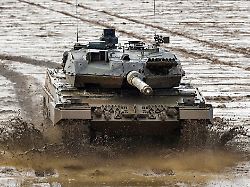Germany supplies the Leopard and the USA, as requested by Scholz, Abrams main battle tanks. This is a success for the chancellor, but not a preliminary decision for Ukraine’s war prospects. It needs a deeper military push that will finally force Russia to negotiate.
Should the US actually send its Abrams tanks to Ukraine, that would be an enormous diplomatic success for Olaf Scholz. The US battle tanks, which are too heavy for many bridges in Ukraine and are highly complex in use, have only limited military value for Ukraine, but the Chancellor has achieved something else: he has ensured that by supplying his own and exporting German tanks Leopard tanks in the Ukraine, the Federal Republic is not alone in the sights of the Russian dictator Vladimir Putin, who is now difficult to assess. With the USA, NATO’s largest nuclear and conventional armed forces are now on board with the provision of Western battle tanks. Scholz has thus fulfilled his oath of office to keep harm away from the German people, even if many experts consider a Russian attack on Germany or another European alliance member to be extremely unlikely anyway.
But Washington’s concession on the Abrams question, the foreseeable export release for other Leopard user states and the delivery of 14 Leopards from the Bundeswehr stocks are not enough. On the contrary: the Chancellor’s approach, which was primarily concerned with Germany’s security, would not go far enough if the deployment of 14 or a few dozen more Leopard tanks remained. The military situation in Ukraine is precarious: Kyiv estimates its need for at least 300 battle tanks. If the defense against Russia’s expected spring offensive succeeds, not an inch of Ukrainian soil will have been recaptured by the occupying forces. And to this day there has been no signal from Berlin that the chancellor has a strategic goal of largely recapturing these areas. Otherwise Germany and Europe would be much further along in their efforts to equip Ukraine.
The red line remains NATO involvement
The Ukrainian soldiers not only lack tanks, but also ammunition. The artillery alone fires 90,000 to 100,000 shots a month – more than the whole of Europe can currently produce in a year. At the same time, the warehouses of the European armies, especially the Bundeswehr required by NATO, are increasingly empty. A strategy is needed to ramp up this production as quickly as possible. A first step would be specific orders to industry and purchase guarantees for all those who are now willing to build up production capacities. The same applies to the repair of the battle tanks and armored personnel carriers lying on the heap. And yes, the debate about possibly equipping Ukraine with Western fighter jets and helicopters must also be able to be conducted without gasping.
Germany’s military aid, which has been increased to 3.3 billion euros, is not nothing. They mean that the Federal Republic is by far one of the biggest supporters of Ukraine, even if not measured in terms of its own economic output. Other EU countries stretch themselves even more. Neither martial law nor international law impose any limits on Western supporters of Ukraine’s arming of conventional weapons as long as the country exercises its legitimate right to self-defense. All of this may be expensive for European taxpayers, but a never-ending war of attrition in Ukraine would cost Europe even more – economically, politically and morally. Consistently supporting this right to self-defense does not mean, as some SPD politicians taunt, escalating the war at any price and ultimately wanting to send German soldiers. Nobody serious is questioning the red line of NATO non-participation.
Kremlin must fear crushing defeat
Switching to a war economy and the comprehensive, long-term supply of highly potent weapon systems from the army’s own stocks are not a step taken lightly. However, they are the necessary consequence if Berlin wants to achieve more than just a ceasefire that somehow comes about, which initially establishes the status quo on the battlefield. The majority of German-speaking Russia experts agree that the very existence of Ukraine and the peace of Europe remain threatened as long as those in power in the Kremlin stick to the narrative that the country has no right to an existence separate from Russia. Because as long as this is the case, every ceasefire remains only an opportunity to prepare for new Russian attacks.
Unless the Russian army suffers such a devastating defeat in the Ukraine that the Russian people won’t need a Kremlin ruler launching a campaign of conquest for decades to come. Such a disastrous defeat in Ukraine must be the threatening scenario with which the West forces Russia to the negotiating table and to withdraw from all territories occupied since February 24 – at least. Reparations payments and a legal investigation of systematic war crimes are also indispensable for a just peace. If Scholz committed himself to such goals in word and deed, instead of his nebulous formulation that Ukraine must not lose, the chancellor could clean up the enormous political damage caused to important allies by his hesitancy in waiting on the tank issue. The government survey in the Bundestag, which begins at lunchtime, would be a first opportunity to do this.
